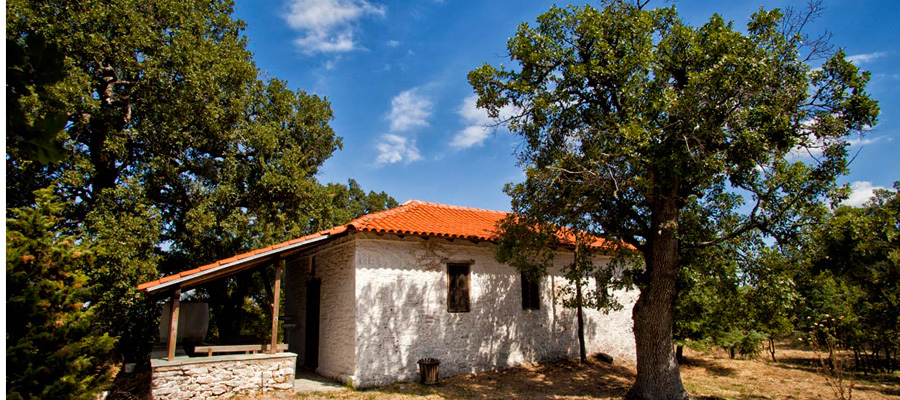Prophet Elias of Arnaia
The hill of Prophet Elias has a great view and was always a key strategic point of the region. It is located near Arnaia and is considered to be the acropolis of ancient Arnaia, mentioned by Thucydides in the Peloponnesian war. The 2003 excavations made by the 10th Ephorate of Byzantine Antiquities headed by archaeologist I. Papaggelos, revealed the wall. Ruins of the acropolis are preserved on the slopes. Pottery, coins and tombs have been discovered. The hill was named after the chapel located there. It is mentioned since the period of the Macedonian struggle (1904-8) but it might have been rebuilt after that. According to researchers, the archaeological site coincides with the position of ancient Arnaia, but this is not totally substantiated. Thucydides probably is the most reliable source of information regarding the ancient city. The great Athenian general and historian, reports that Spartan general Vrasidas departed from the city, and headed to Amfipoli with his army.
΄Επί ταύτην (τήν ΄Αμφίπολιν) ουν ο Βρασίδας άρας εξ’ ΄Αρνών της Χαλκιδικής επορεύετο τω στρατώ και αφικόμενος περί δείλην επί τον Αυλώνα και Βορμίσκον.
(Thucydides IV, 103).
Based on historical data and archaeological findings, it is assumed that the location of the ancient city of Arnai was north of the hill of Prophet Elias. According to other archaeologist researchers, there was another city built around the hill named Avgaia, and had its acropolis built at the top. It is said that Arnai was a colony of Andrians, an assumption reinforced by the fact that a city named Arni is mentioned in Andros, after the Persian wars. The reason and the time of the destruction of Arnai are also unknown. It may had the fate of other cities of the Olynthian Federation, that were destroyed by the king of Macedonia Philip II.
It is confirmed though, that human presence in the hill of Prophet Elias was already organized since the prehistoric era (about 15th century B.C.) and continued almost uninterrupted until the 14th century B.C. The reasons why the region was constantly populated are obvious: it has natural fortification, it has drinking water, it has fertile properties in the nearby valley, it is well forested and the areas with the mines -from Stanos to Isvoros- are relatively close.
Indications show that the settlement of Prophet Elias, or the so called Ai-Lia, firstly flourished during the 5th and 4th centuries B.C. and then for a second time during Roman rule. These periods must be directly related to the increase in mining activity in the region, which was rich in silver and gold deposits since the ancient era. Furthermore, there are clear indications that support this theory, since structural material used for the castle and the houses of the medieval settlement came from the cutting of the stone grinders, equipment of the ancient mines.
While historical sources confirm that the roman settlement existed until the 4th century B.C. and was probably destroyed in the middle 6th century, excavations show that a post-byzantine settlement on top of which the castle and the later settlement were built, existed on the hill of Prophet Elias. The castle encloses an area of 2.200 sq.m, had a shape of an irregular circle and was built on the top of the hill with stones used in previous structural phases. Some parts are preserved until 2m in height, and according to archaeologists it was no more than 5m in height. It was built with mud and a plaster had been used only in some parts of the outer side.
Info
Additional data regarding the archaeological site of Prophet Elias were taken from the article “The excavation at the hill of Prophet Elias of Arnaia during the year 2003”, by the archaeologist Dr. Joachim Ath. Papaggelos, which is included in the book “The archaeological site of the hill of Prophet Elias of Arnaia” by Dimitrios Th. Kyros.






